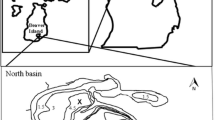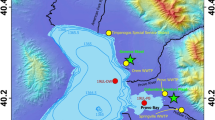Abstract
We used paleolimnological methods to evaluate historical water quality in Lake Thonotosassa, Hillsborough County, Florida, USA. Sediment mapping shows that organic deposits are unevenly distributed in the lake. Two short (<130 cm) sediment cores from the depositional zone were analyzed for radioisotopes (210Pb, 226Ra, and 137Cs), bulk density, organic matter concentration, nutrients (C,N,P), and diatoms. 210Pb results indicate that the profiles represent > 100 years of sediment accumulation. There is an abrupt change in sediment composition at about the turn of the century (∼80 cm depth), above which bulk density decreases and concentrations of organic matter, total C, total N, total P, and 226Ra activity increase. Diatom-based reconstructions of historical water-column trophic conditions indicate progressive nutrient enrichment in the lake during the past ∼100 years. Stratigraphic changes in diatom assemblages suggest that anthropogenic nutrient loading converted Lake Thonotosassa from a naturally eutrophic system to a hypereutrophic waterbody after ∼1900. Given the edaphic setting of Lake Thonotosassa, efforts to mitigate recent anthropogenic impacts will, at best, yield the eutrophic conditions that characterized the lake prior to human disturbance. This study illustrates the importance of paleolimnological data for targeting realistic water quality conditions when lake restoration is contemplated.
Similar content being viewed by others
References
Anderson, N. J., 1993. Natural versus anthropogenic change in lakes: the role of the sediment record. Trends in Ecology and Evolution (TREE) 8: 356–361.
Anderson, N. J., B. Rippey & C. E. Gibson, 1993. A comparison of sedimentary and diatom-inferred phosphorus profiles: implications for defining pre-disturbance nutrient conditions. Hydrobiologia 253: 357–366.
Appleby, P. G. & F. Oldfield, 1983. The assessment of 210Pb data from sites with varying sediment accumulation rates. Hydrobiologia 103: 29–35.
Appleby, P. G., P. J. Nolan, D. W. Gifford, M. J. Godfrey, F. Oldfield, N. J. Anderson & R. W. Battarbee, 1986. 210Pb dating by low background gamma counting. Hydrobiologia 143: 21–27.
Binford, M. W. & M. Brenner, 1986. Dilution of 210Pb by organic sedimentation in lakes of different trophic states, and application to studies of sediment-water interactions. Limnol. Oceanogr. 31: 584–595.
Brenner, M. & T. J. Whitmore, 1991. Lake Seminole Sediment Characterization and Analysis. Report for Southwest Florida Water Management District, Brooksville, FL.
Brenner, M., M. W. Binford & E. S. Deevey, 1990. Lakes. In R. L. Myers & J. J. Ewel (eds), Ecosystems of Florida.. University of Central Florida Press, Orlando: 364–391.
Brenner, M., A. J. Peplow & C. L. Schelske, 1994. Disequilibrium between 226Ra and supported 210Pb in a sediment core from a shallow Florida lake. Limnol. Oceanogr. 39: 1222–1227.
Brenner, M., T. J. Whitmore, M. S. Flannery & M. W. Binford, 1993. Paleolimnological methods for defining target conditions in lake restoration: Florida case studies. Lake and Reserv. Mgmt 7: 209–217.
Brenner, M., T. J. Whitmore, J. H. Curtis & C. L. Schelske 1995. Historical ecology of a hypereutrophic Florida lake. Lake & Reserv. Mgmt 11: 255–271.
Brooks, H. K., 1981. Geologic map of Florida. Institute of Food and Agricultural Services, Univ. of Florida, Gainesville.
Canfield, D. E., Jr. 1981. Final report: Chemical and trophic state characteristics of Florida lakes in relation to regional geology. Institute of Food and Agricultural Studies, Univ. of Florida, Gainesville: 434 p.
Canfield, D. E., Jr. & M. V. Hoyer, 1988. Regional geology and the chemical and trophic state characteristics of Florida lakes. Lake & Reserv. Mgmt 4: 21–31.
Cowell, B. C., C. W. Dye & R. C. Adams, 1975. A synoptic study of the limnology of Lake Thonotosassa, Florida. Part 1. Effects of primary treated sewage and citrus wastes. Hydrobiologia 46: 301–345.
Fisher, M. M., M. Brenner & K. R. Reddy, 1992. A simple, inexpensive piston corer for collecting undisturbed sediment/water interface profiles. J. Paleolimnol. 7: 157–161.
Håkanson, L., 1981. A manual of lake morphometry. Springer-Verlag, NY 78 pp.
Håkanson, L. & M. Jansson, 1983. Principles of lake sedimentology. Springer-Verlag, NY 316 pp.
Huber, W. C., P. L. Brezonik, J. P. Heaney, R. E. Dickinson, S. D. Preston., D. S. Dwomik & M. A. DeMaio, 1982. A classification of Florida lakes. Report ENV-05-82-1 to the Florida Department of Environmental Regulation, Tallahassee, FL.
Keating, K. I., 1978. Blue-green algal inhibition of diatom growth: transition from mesotrophic to eutrophic community structure. Science 199: 971–973.
Kenner, W. E., 1964. Maps showing depths of selected lakes in Florida. Florida Geological Survey Information Circular No. 40, Tallahassee, FL. 82 pp.
Krishnaswami, S. & D. Lal, 1978. Radionuclide limnochronology. In A. Lerman (ed.), Lakes: chemistry, geology, physics. Springer-Verlag, New York: 153–177.
Schelske, C. L., D. J. Conley, E. F. Stoermer, T. L. Newberry, C. D. Campbel, 1986. Biogenic silica and phosphorus accumulation in sediments as indices of eutrophication in the Laurentian Great Lakes. Hydrobiologia 143: 79–86.
Schelske, C. L., A. Peplow, M. Brenner & C. N. Spencer, 1994. Low-background gamma counting: applications for 210Pb dating of sediments. J. Paleolimnol. 10: 115–128.
Smeltzer, E. & E. B. Swain, 1985. Answering lake management questions with paleolimnology. In Lake Reserve. Mgmt — Practical Applications. Proc. 4th Annu. Conf. and Symp. (NALMS): 390 pp.
Van der Werff, A., 1955. A new method of concentrating and cleaning diatoms and other organisms. Int. Ver. Theor. Angew. Limnol. Verh. 12: 276–277.
Vernon, R. O. & H. S. Puri, 1964. Geologic map of Florida. Florida Bur. Geol. Map Ser. 18, Tallahassee.
Whitmore, T. J., 1989. Florida diatom assemblages as indicators of trophic state and pH. Limnol. Oceanogr. 34: 882–895.
Whitmore, T. J., M. Brenner & C. L. Schelske, 1996. Highly variable sediment distribution in shallow, wind-stressed lakes: a case for sediment-mapping surveys in paleolimnological studies. J. Paleolimnol. 15: 207–221.
Author information
Authors and Affiliations
Additional information
Journal Series No. R-05019 of the Florida Agricultural Experiment Station
Rights and permissions
About this article
Cite this article
Brenner, M., Whitmore, T.J. & Schelske, C.L. Paleolimnological evaluation of historical trophic state conditions in hypereutrophic Lake Thonotosassa, Florida, USA. Hydrobiologia 331, 143–152 (1996). https://doi.org/10.1007/BF00025415
Received:
Revised:
Accepted:
Issue Date:
DOI: https://doi.org/10.1007/BF00025415




